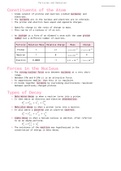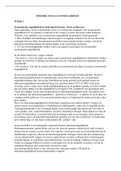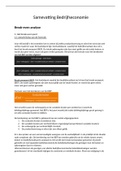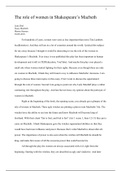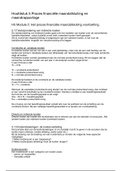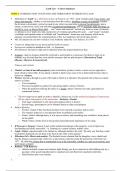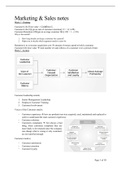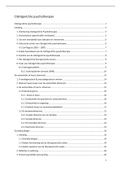Particles and Radiation
Constituents of the Atom
☆ Atoms consist of protons and neutrons (called nucleons) and
electrons.
☆ The nucleons are in the nucleus and electrons are in orbitals.
☆ The proton and electron have equal and opposite charges.
☆ Specific charge is the ratio of charge to mass.
☆ This can be of a nucleus or of an ion.
☆ An isotope is a form of an element’s atom with the same proton
number but a different number of neutrons.
Particle Relative Mass Relative Charge Mass Charge
Proton 1 +1 1. 6 × 10
−27 −19
+ 1. 6 × 10
Neutron 1 0 1. 6 × 10
−27
0
Electron 0.0005 -1 9. 11 × 10
−31 −19
− 1. 6 × 10
Forces in the Nucleus
☆ The strong nuclear force acts between nucleons at a very short
range.
☆ Between 3fm and 0.5fm it is an attractive force.
☆ At separations smaller than this it is repulsive.
☆ It holds together nucleons by overcoming electrostatic repulsion
between positively charged protons.
Types of Decay
☆ Beta minus decay is when a neutron turns into a proton.
☆ It then emits an electron and electron antineutrino.
𝐴 𝐴 0 0
𝑋𝑍 → 𝑌𝑍+1 + 𝑒−1 + ν𝑒
0
☆ Beta plus decay is when a proton turns into a neutron.
☆ It also emits a positron and an electron neutrino.
𝐴 𝐴 +0 0
𝑋𝑍 → 𝑌𝑍−1 + 𝑒 +1
+ ν𝑒
0
☆ Alpha decay is when a helium nucleus is emitted, often referred
to as an alpha particle.
𝐴 𝐴−4 4
𝑋𝑍 → 𝑌𝑍−2 + α2
☆ The existence of the neutrino was hypothesised in the
conservation of energy in beta decay.
, Particles and Radiation
Photons
☆ The energy of a photon, which has wave-like properties, can be
shown by combining a few equations and constants.
𝑃𝑙𝑎𝑛𝑐𝑘'𝑠 𝐶𝑜𝑛𝑠𝑡𝑎𝑛𝑡 × 𝑆𝑝𝑒𝑒𝑑 ℎ𝑐
Energy of a Photon = 𝑊𝑎𝑣𝑒𝑙𝑒𝑛𝑔𝑡ℎ
𝐸 = λ
☆ We know that electromagnetic waves (and therefore photons) travel
at the speed of light, and we also know that Planck’s constant.
☆ We can put these two constants into the equation and use that to
find the energy
−34 8
(6.63×10 )×(3×10 )
Energy of a Photon = 𝑊𝑎𝑣𝑒𝑙𝑒𝑛𝑔𝑡ℎ
Antimatter
☆ Antiparticles have the same mass/rest energy but the opposite
charges and other quantum numbers compared to their normal matter
counterparts.
☆ A particle and corresponding antiparticle annihilate each other
in an annihilation reaction, releasing two photons.
☆ The photons must go in different directions to conserve momentum.
2𝐸𝑚𝑖𝑛 = 2𝐸𝑟𝑒𝑠𝑡 → 𝐸𝑚𝑖𝑛 = 𝐸𝑟𝑒𝑠𝑡 → ℎ𝑓 = 𝐸𝑟𝑒𝑠𝑡 + 𝐸𝑘
Pair Production
☆ A photon interacts with a nucleus and its energy is converted
into the mass of a particle and its corresponding antiparticle.
𝐸𝑚𝑖𝑛 = 2𝐸𝑟𝑒𝑠𝑡 → ℎ𝑓 = 2𝐸𝑟𝑒𝑠𝑡 + 𝐸𝑘
Particle Interactions
☆ There are 4 fundamental interactions: the weak nuclear, the
strong nuclear, the electromagnetic interaction and gravity.
☆ Exchange particles are the force carriers for the fundamental
forces.
☆ They transfer energy, momentum, force and sometimes charge.
☆ The size of the exchange particle determines the range of the
force; the bigger the particle, the shorter the range.
Type Gauge Boson Particles Affected
Strong Pions Hadrons
Electromagnetic Virtual Photon Charged Particles
Weak W-/W+ Bosons All Types
Constituents of the Atom
☆ Atoms consist of protons and neutrons (called nucleons) and
electrons.
☆ The nucleons are in the nucleus and electrons are in orbitals.
☆ The proton and electron have equal and opposite charges.
☆ Specific charge is the ratio of charge to mass.
☆ This can be of a nucleus or of an ion.
☆ An isotope is a form of an element’s atom with the same proton
number but a different number of neutrons.
Particle Relative Mass Relative Charge Mass Charge
Proton 1 +1 1. 6 × 10
−27 −19
+ 1. 6 × 10
Neutron 1 0 1. 6 × 10
−27
0
Electron 0.0005 -1 9. 11 × 10
−31 −19
− 1. 6 × 10
Forces in the Nucleus
☆ The strong nuclear force acts between nucleons at a very short
range.
☆ Between 3fm and 0.5fm it is an attractive force.
☆ At separations smaller than this it is repulsive.
☆ It holds together nucleons by overcoming electrostatic repulsion
between positively charged protons.
Types of Decay
☆ Beta minus decay is when a neutron turns into a proton.
☆ It then emits an electron and electron antineutrino.
𝐴 𝐴 0 0
𝑋𝑍 → 𝑌𝑍+1 + 𝑒−1 + ν𝑒
0
☆ Beta plus decay is when a proton turns into a neutron.
☆ It also emits a positron and an electron neutrino.
𝐴 𝐴 +0 0
𝑋𝑍 → 𝑌𝑍−1 + 𝑒 +1
+ ν𝑒
0
☆ Alpha decay is when a helium nucleus is emitted, often referred
to as an alpha particle.
𝐴 𝐴−4 4
𝑋𝑍 → 𝑌𝑍−2 + α2
☆ The existence of the neutrino was hypothesised in the
conservation of energy in beta decay.
, Particles and Radiation
Photons
☆ The energy of a photon, which has wave-like properties, can be
shown by combining a few equations and constants.
𝑃𝑙𝑎𝑛𝑐𝑘'𝑠 𝐶𝑜𝑛𝑠𝑡𝑎𝑛𝑡 × 𝑆𝑝𝑒𝑒𝑑 ℎ𝑐
Energy of a Photon = 𝑊𝑎𝑣𝑒𝑙𝑒𝑛𝑔𝑡ℎ
𝐸 = λ
☆ We know that electromagnetic waves (and therefore photons) travel
at the speed of light, and we also know that Planck’s constant.
☆ We can put these two constants into the equation and use that to
find the energy
−34 8
(6.63×10 )×(3×10 )
Energy of a Photon = 𝑊𝑎𝑣𝑒𝑙𝑒𝑛𝑔𝑡ℎ
Antimatter
☆ Antiparticles have the same mass/rest energy but the opposite
charges and other quantum numbers compared to their normal matter
counterparts.
☆ A particle and corresponding antiparticle annihilate each other
in an annihilation reaction, releasing two photons.
☆ The photons must go in different directions to conserve momentum.
2𝐸𝑚𝑖𝑛 = 2𝐸𝑟𝑒𝑠𝑡 → 𝐸𝑚𝑖𝑛 = 𝐸𝑟𝑒𝑠𝑡 → ℎ𝑓 = 𝐸𝑟𝑒𝑠𝑡 + 𝐸𝑘
Pair Production
☆ A photon interacts with a nucleus and its energy is converted
into the mass of a particle and its corresponding antiparticle.
𝐸𝑚𝑖𝑛 = 2𝐸𝑟𝑒𝑠𝑡 → ℎ𝑓 = 2𝐸𝑟𝑒𝑠𝑡 + 𝐸𝑘
Particle Interactions
☆ There are 4 fundamental interactions: the weak nuclear, the
strong nuclear, the electromagnetic interaction and gravity.
☆ Exchange particles are the force carriers for the fundamental
forces.
☆ They transfer energy, momentum, force and sometimes charge.
☆ The size of the exchange particle determines the range of the
force; the bigger the particle, the shorter the range.
Type Gauge Boson Particles Affected
Strong Pions Hadrons
Electromagnetic Virtual Photon Charged Particles
Weak W-/W+ Bosons All Types

